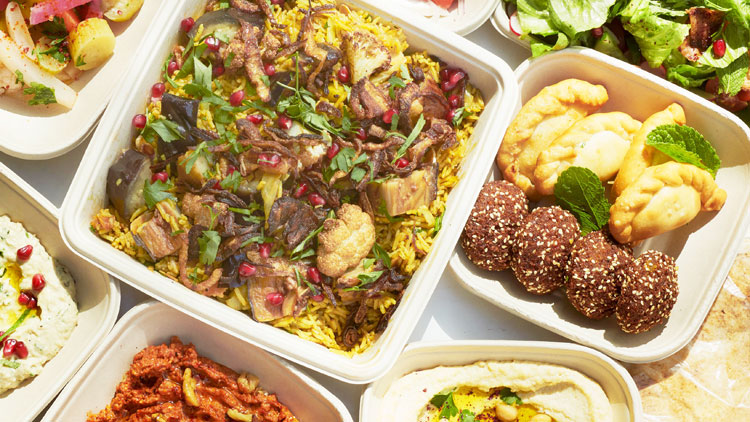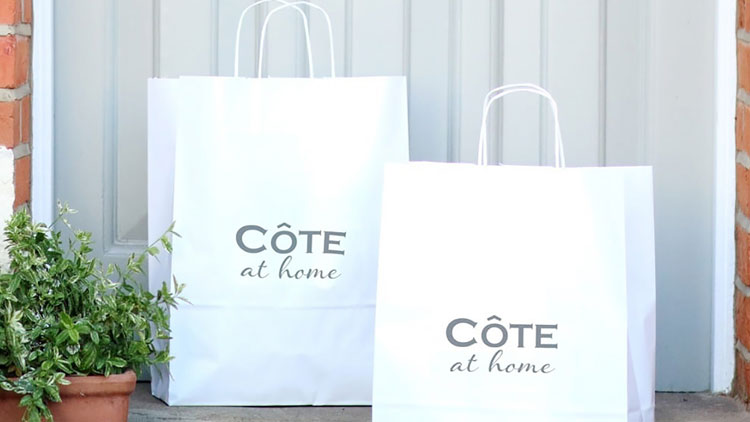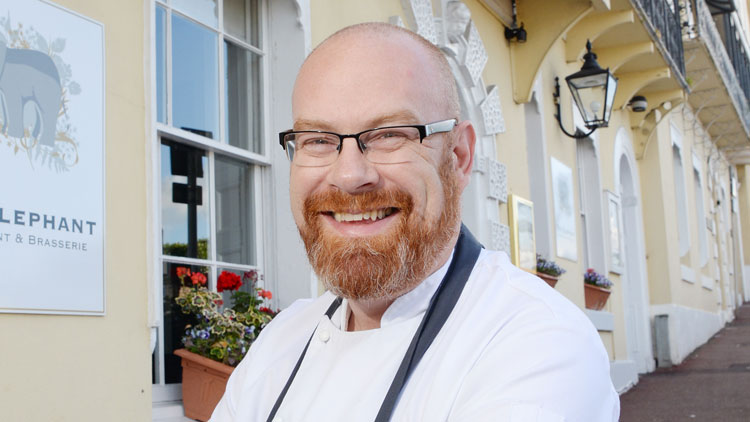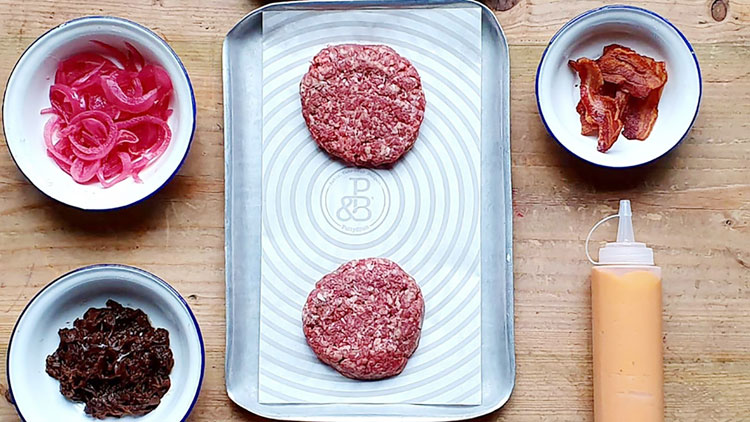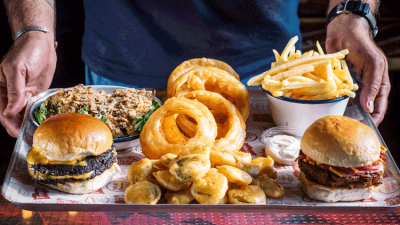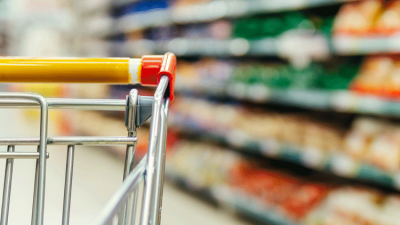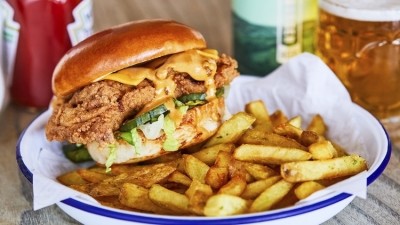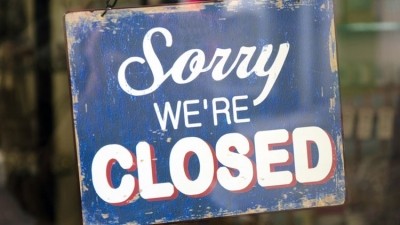Stand and deliver: how restaurants have turned to takeaway and delivery in order to survive
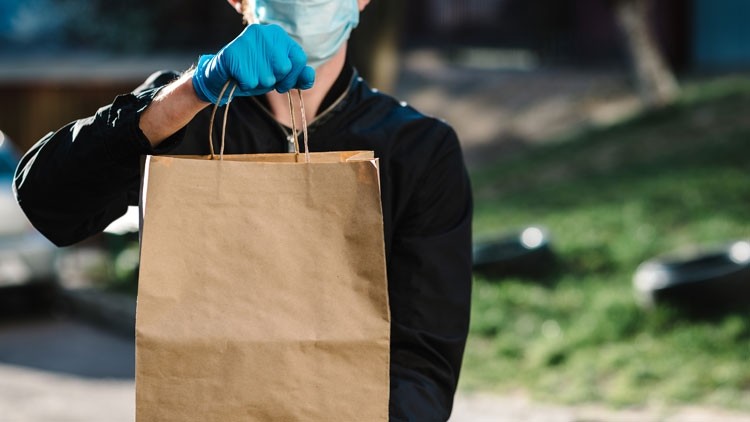
A delivery driver knocks on the door, sets down a rectangular cardboard box and – as lockdown etiquette dictates – steps back a few metres. Inside the box is everything needed to make four Patty & Bun burgers: four patties, a generous amount of streaky bacon, four buns, four slices of Red Leicester and a pot of Smokey P&B Mayo. Supplied by the London and Brighton-based burger group’s own butcher HG Walter and neatly presented on the same paper that Patty & Bun uses to wrap its burgers, the ingredients are identical to those used in the restaurants.
The only other things needed are a some baby gem leaves and few slices of tomato. The barbecue is fired-up (Patty & Bun’s printed method stipulates a ripping-hot frying pan, but the sunny day dictates otherwise) and in less than 20 minutes after the package arrives, near restaurant-quality burgers have been created.
The finished product is far superior to anything most people could make at home thanks to Patty & Bun providing both high-quality ingredients and distilling years of burger making know-how onto an A5 sheet (detailed building instructions help the burger stay together beautifully). Priced at £25 for four plus £6 for delivery, the burgers work out at about £7.50 each, roughly £2.50 less than in the restaurants, and have so far proven to be a popular affordable luxury, with Patty & Bun and HG Walter struggling to keep up with demand.
Moves into meal kits
While delivery per se is nothing new to the burger group, which has long offered its burgers through delivery platforms such as Deliveroo, the DIY nature of its latest venture is, and is one born entirely out of necessity. Patty & Bun, like every restaurant business in the country – from small independents right up to the largest of groups – saw its revenue stream turned off last month after the Government ordered a shutdown of businesses across the country, including restaurants and pubs, as the Coronavirus pandemic took hold.
With no cash coming in but bills still to pay and the threat of rent payments looming large, all restaurant businesses in the sector now find themselves in a perilous situation on an unprecedented scale. As hospitality businesses endure the second three-week phrase of lockdown owners have been left wondering whether they will even have a restaurant to reopen once the restrictions are eventually lifted.
The only small sliver of light is that restaurant businesses have been permitted by the Government to continue to operate a takeaway or delivery service, and this is an option some have turned to – some out of desperation, some to look after their staff, but all ultimately for the same purpose: survival.
“This is a period of adapting – you can either go on the defensive or the attack; we are trying to go on the attack in terms of being as creative as we possibly can,” says Patty & Bun founder Joe Grossman. “We had wanted to do a BBQ kit for the past couple of years but had been so busy we didn’t have the time. You are always making excuses when you’re on the growth plan but then the shit hit the fan and we thought ‘fuck, we need to do this’.”
“Luckily we had the tools available and the logistics to do it. We’ve almost launched a separate business.”
Grossman says the DIY kits were devised as being a good extension of the brand, “something fun and engaging that allows us to come into peoples homes and bring a little bit of positivity and fun into these dark times”. Yet it soon became clear that they could be used for much more. While he admits it isn’t a massive money spinner (“but every penny helps right now”) he is proud that the kits are helping support the restaurants’ supply chain in this time of need.
“If we’ve got the opportunity to order in from our suppliers and feed that ecosystem then that’s amazing. That for me is the most important thing; these suppliers are who we are. Many are not being paid, and it’s hard to hear that because without that ecosystem there is no restaurant industry.”
A pivot from eat-in to takeaway
Patty & Bun is by no means alone in its endeavours. Restaurants and groups the breadth of the country have pivoted from a standard eat-in model to offer delivery and takeaway while others have redoubled their existing efforts in the delivery arena.
The burger group is also not alone in diversifying its offer by selling meal kits. London-based pizza group Pizza Pilgrims has brought back its Frying Pan Pizza Kit that contains the ingredients to make two pizzas at home. The kits were previously available to order through Deliveroo from all of its restaurant sites but it stopped production once its restaurants closed. Last month, however, it reopened its Victoria restaurant, which is being used to prepare the kits as well as for takeaway, with the kits now available for delivery nationwide.
Plant-based burger group The Vurger Co has also created a meal kit that contains all the components needed to make its burgers and dessert specialist Chin Chin has released two ‘starter kits’ for its marshmallow hot chocolate; and griddled cookie dough.
"This is a period of adapting – you can either go on the defensive
or the attack; we are trying to go on the attack
in terms of being as creative as we possibly can"
Two-strong India restaurant group Gunpowder is also looking to create DIY kits, as well as ready made meals that just require heating up. Founder Harneet Baweja says that home delivery meal kit companies such as Pasta Evangelists have paved the way for people making restaurant-quality food at home.
“We can learn from people like [Pasta Evangelists]. If you can’t learn from your peers and adapt you’re going to die. Indian food is not like making pasta, but we should be able to take it there.”
For Baweja, ensuring a regular and consistent supply of ingredients represents one of the biggest challenges. “The whole supply chain is something I’m very worried about. Restaurants are shut, everyone is cooking at home, and there has been a massive supply chain shift. Our food has to take that into consideration. We are figuring out with suppliers what is available and what we can use to get a consistent product.”
In addition to meal kits, Baweja is looking into making Indian ready-made meals – which he refers to as ‘TV dinners’. “Traditionally in India people cooked with cow dung as a source of fuel. It didn’t produce a high flame but a low burn. A lot of Indian food is slow and low and that’s what these dishes will be.”
In a change of tack, bread is also likely to form an important part of Gunpowder’s delivery offer – despite the fact that it plays no part in either of its restaurants. When Gunpowder opened, Baweja decided against serving bread to focus on a more produce-driven menu but in this time of lockdown bread, he says, has become more significant.
“Indian food gets a bad reputation for being curry and doughy bread and being heavy on the tummy, which is why we stayed away from it. But moving into the future we might have to look at bread again. What is the one thing people in lockdown always want? It’s bread. It’s a basic primal instinct.”
High-end restaurants whose food style and vibe doesn’t exactly scream delivery have taken the plunge. Mayfair restaurant Hide has launched a delivery service through platform Supper, with the Michelin star restaurant serving dishes ‘that travel well’ within a two-and-a-half mile radius. These have included suckling pig with mustard fruit puree, crushed turnip and black pudding; and roast dry-aged duck lacquered in honey, lavender and spices. Wines from sister operation Hedonism are also be available to order
Heron Tower-based restaurants Sushisamba and Duck & Waffle are also delivering dishes - within a five-miles radius - including samba rolls; duck and waffle; tiraditos and even robata-grilled kobe ribeye steak.
London-based Middle Eastern restaurant Arabica has also introduced a home delivery service with menu items including falafel meal kits, Middle Eastern dips and salads; vegan and vegetarian mezze platters; and a meat-based family feast box. Arabica’s own brand ingredient jars will also be available to order, including tahini, sumac, za’atar and their sweet and sour pomegranate molasses.
Even two Michelin starred chef Simon Rogan has got in on the act, serving ingredients from his restaurants’ farms that would have otherwise gone to waste. Dishes are prepared, frozen and vacuum sealed for re-heating and have included creamy chicken with quinoa, spinach and leeks; and grilled pork ribs with seasonal vegetables.
“We take great pride in our staff meals and we encouraged our staff to take an interest in providing hearty nutritious meals,” says Rogan. “It’s the stuff us chefs love to cook at home.”
Doing it the French way
Another significant move in the food delivery field has been Côte at Home. While the majority of the UK’s large casual dining chains have put up the barriers and ceased operations entirely, the French-inspired group has made the switch from eat-in to delivering its dishes directly to customers.
Available to people within the M25, and further afield, dishes such as pea, mint and courgette soup; beef bourginon; hachis parmentier; and smoked haddock and salmon fishcakes; and apple crumble are served ready to be cooked or frozen. In addition, Cote is delivering a wide range of its wines and even meats from its butchery.
French food lends itself particularly well to restaurant quality ready-meals, according to Simon Hulstone, chef-patron at Michelin-starred The Elephant restaurant in Torquay. Hulstone has started preparing takeaway meals from his restaurant kitchen for customers to pick up and says that so far French dishes have been a mainstay of the menu.
“We’ve been doing classic French dishes such as beef bourguignon, cassoulet and coq au vin, which are both full on flavour and easy to reheat,” he says. “We’re not doing anything special – it is never going to be The Elephant’s food at home, it’s more like airline food that I’m taking to first class level. But people are loving it. They are sick of eating jacket potatoes at home. The people who come to eat with us don’t cook, they have the money to eat out so why would they? For them it’s perfect.”
"It’s heartbreaking. We’ve gone from five or six chefs in the kitchen
to just me banging out food on my own as well as doing
all the washing up and packing. It’s lonely work"
That said, the food is significantly more involved than that on offer through the likes of Deliveroo, with recent meals including new season lamb with peas, onions, spiced sausage, bacon and roast new potatoes; Brixham hake with mussel and fennel cream sauce, leak, asparagus and saffron potatoes; and halibut, salmon and shellfish fishcake with lobster and lemongrass cream and summer vegetables.
Dishes are ultimately dependent on what ingredients Hulstone can get his hands on, with cheaper cuts being used to keep prices down. While The Elephant does have its own farm at its disposal, Hulstone says the nine-mile distance of the farm to the restaurant doesn’t make it a viable option (the farm is instead delivering vegetable boxes locally).
The Elephant’s takeaway service is “purely for survival” says Hulstone, in order to help him continue to pay his restaurant’s utility bills and to keep some money coming through the door. He initially put up a post on the restaurant’s Facebook account asking if anyone would be interested in it doing takeaway and the high number of responses encouraged him to take the plunge.
The Elephant now makes around 60 meals a day on Tuesdays, Thursdays, and Saturdays that are available for people to collect within a two-hour window and reheat at home. It charges £15-17 for two courses – a main and a dessert – which is in line with The Elephant’s lunchtime menu of two courses for £19 (the takeaway food is VAT exempt because it is cold) with additional sides and items such as sourdough, cheeses and chutneys also available (stock permitting).
Although popular, the enterprise is not without its challenges. Hulstone says demand is there for greater numbers but that he can only physically make around 50-60 meals because he is doing it on his own, the rest of the kitchen brigade having been put on furlough. “It’s heartbreaking. We’ve gone from five or six chefs in the kitchen to just me banging out food on my own as well as doing all the washing up and packing. It’s lonely work.”
As for menu planning, this isn’t done too far in advance because Hulstone doesn’t know what suppliers will be around (a number of his regular suppliers have since stopped trading) and what produce will be available. As a result, menus are only released a week in advance. “There’s no staff food and I’m not making stock so I’m ordering exactly what I need so there is no waste.”
Keeping a hand in
Back in London, Jackson Boxer, chef-patron of Orasay in Notting Hill and Brunswick House in Vauxhall, is also serving restaurant-quality food as both takeaway and delivery. Like Grossman, Boxer says the enterprise came from a desire to keep being able to pay suppliers as well as rent.
“My landlords have been very kind and supportive – it’s their only source of income. They are not rapacious vultures and have been very understanding and I felt a bit beholden to them to continue to attempt to pay something. I have suppliers I owe money to as well and many are in a worse situation as they don’t have the ability to start finding their way into retail.
“We have cash reserves that might allow us to stay dormant for maybe five or six weeks but the idea of sitting tight when the money dwindles away, I couldn’t bear it. I had regulars who might like to be cooked for and a kitchen going begging. This is not a money-making exercise – we are looking to bring in enough cash to pay suppliers and our team on the payroll and pay the rent. All the things that make it expensive to run a restaurant are on hold.”
Orasay at Home has been something of a baptism of fire for Boxer, who says he started out trying to deliver the same kind of dishes served in the restaurant but soon realised the approach was simply not viable.
“We initially attempted to cook food a la minute but it was a nightmare and very complicated,” he explains. “Trying to expedite couriers in London on a Friday night was staggering in terms of stress. It’s like opening a restaurant from scratch with no cash and no idea. It was clear to me that we lacked the resources and the know-how to be able to do that.”
Boxer has since slimmed down the Orasay at Home offer and, like Hulstone, is no longer cooking restaurant food but instead “the kind of food I love when I have three or four days of prep”. These include half a Black Leg chicken with madeira sauce; 24-hour braised short rib with celeriac puree; Datterini tomatoes, grilled chickpeas, basil and hazelnut pesto; pot roast duck leg with smoked bacon and red wine; and potato bread with smoked cod’s roe.
“It’s homely, comforting food using sophisticated techniques, stocks and sauces and ferments that we’ve made. It’s very simple to plate but in an intuitive way – it’s an approximation of carefully presented
restaurant food.”
"For the past 10 years I have gone into a kitchen and cooked
what I want to eat. I don’t known in what world we
will reopen but by doing this I keep in the habit"
Boxer says he is changing the format on a daily basis for what works for the restaurant and its customers. “I’m completely winging it, I’ve no fucking idea what I’m doing, but I’m not uncomfortable with that. I’ve never had significant help in the past and I’ve always taken a DIY approach to things, it’s all I know.”
On the first night the restaurant did 40 people, which Boxer says felt good; the second night it doubled it to 80, “which was hell”. He has since limited the orders it can do at any one time and staggers them between 12pm and 9pm. Meals are available for pick up or for delivery via white-label e-commerce solution Slerp, and while it can’t handle the number of orders as platforms such as Just Eat and Deliveroo, Boxer says the numbers it can do are “appropriate for a small operation like ours”.
He says he did look at the likes of Deliveroo and Uber Eats but the finances just didn’t stack up. “It would mean we would have to put our prices up so much to meet the commission that we felt we would end up charging too much. I was keen to not alienate loyal customers.”
There are other reasons behind Boxer’s move into delivery, including a desire to keep busy. “I want to keep occupied and not spin into a spiral of anxiety. We do new things every day to keep me and the team engaged.
"I make it as much like working in a restaurant kitchen as possible so that it is stimulating, challenging and engaging for my team, otherwise it can get boring quite quickly. It is easy to invest care and love [in something] when you are interested.”
Another motivator is purely to keep his hand in. “For the past 10 years I have gone into a kitchen and cooked what I want to eat – it’s Zeitgeisty and gives me a feeling of where we’re at. I don’t known in what world we will reopen but by doing this I keep in the habit.
“Being able to cook in these changing times gives me a better understanding of what’s making people happy right now. I cooked through the 2008 recession when people’s habits changed dramatically. It’s an intensely challenging experience, but I am lucky to have something to do to fill the void.”
A return to delivery
As the lockdown has been extended, a number of groups that had operated in the delivery space but which stopped when restaurants were told to close have since begun to reopen select sites. Chief among them have been the fast food players, with KFC, Burger King, Shake Shack and Five Guys among those reopening restaurants in latter part of last month.
More recently, MEATliquor reopened its East Dulwich restaurant, with a promise of more reopenings if successful, and Honest Burgers intends to reopen a number of its restaurants at the start of this month. Honest Burgers initially switched to a delivery-only model in the early days of the Coronavirus pandemic but closed them at the end of March.
”We want to keep hold of our guys and as employers we have a responsibility to start greasing the wheels of the economy too,” says co-founder Tom Barton. “For all we know we could still be in this situation in 12 months time.”
The group is reopening those of its restaurants that generate the most profit. “But profit for us right now is about getting revenue into the business to ensure we don’t have to do anything drastic when the Government support falls away,” adds co-founder Philip Eeles. “We’re trying to protect the business and the people that make up our business. We need to get back open as quickly and as safely as we can.”
So where does this leave restaurants in the short term? For many, a pivot into delivery is a short-term necessity, and even then it’s just a sticking plaster used to cover a gaping wound. As Boxer says: “On paper it makes no sense, we are selling a product with already tight margins cheaper and in bigger portions – it is not sustainable.”
"At times like this you have to reinvent yourself, reduce your menu
and get an online platform. You need to look at takeaway
because that is going to be the future"
There are some, however, that see a forced shift into delivery as a sign of how their businesses will have to operate in the future. Emilio Malik, founder of Mayfair-based Lazeez Lebanese Tapas and Liban Tapas in South Woodford, believes the takeaway delivery service he set up as a result of Coronavirus will shape how his businesses operate in the future.
Both restaurants now offer a special takeaway menu and food collection service based on the experience Malik gained while operating a unit out of Boxpark in Croydon. While that business eventually closed, with Malik citing logistical reasons for the closure, he says he is using the tapas-style menu it served as the model for his takeaway offer.
Liban’s takeaway menu went from concept to going live, via a clickthrough on its website, in just five days and features hot and cold tapas boxes (any three for £8.95) as well as wraps and salads, which Malik says are a “quick and efficient” way of serving food. “I had the menu in my head and I knew it had to be simple to get out. An online business and a restaurant business are two very different things. The packaging has to work, which is why the tapas boxes are good.”
Malik is also working with e-commerce and delivery platform Vita Mojo to bring the menu at Lazeez Lebanese Tapas to customers, a move which he says will make it the first Lebanese restaurant on the platform.
“At times like this you have to reinvent yourself, reduce your menu and get an online platform. You need to look at takeaway because that is going to be the future.” He predicts that 25-35% of the restaurants’ total sales will be takeaway from now on.
“Otherwise we’re not going to be able to survive. For a while people will be reluctant to go into restaurants [once lockdown ends]. This is something that we are going to spend a lot more time and resources on. I see this as the future.”
And what of Patty & Bun? Grossman says the popularity of its DIY kits has exceeded expectations to the point that he has extended the range to incorporate its plant-based burgers. The company at present caps its orders at 250 kits a day, but is speaking with logistic companies to ramp up the numbers and eventually take the offer nationwide.
What’s more, the kits are likely to become a permanent fixture of Patty & Bun’s business. “The reaction has been humbling to say the least. It was launched as a short-term thing to engage with people but it has evolved organically. Breaking the process down bit by bit is great – we’ve nowhere to hide in terms of the quality of the products we use. This is us as a company in a box and I definitely think it will be something that will continue.
“If we do it nationwide it becomes a great way for people to get the Patty & Bun experience and that real connection with the brand without having to come to London or Brighton. We started with the restaurants, when delivery didn’t exist, and then the landscape changed and we moved into delivery.
“Now the landscape has shifted again and we are currently only doing delivery. If you look at it from that perspective, if you have a plan and are able to adapt then it’s an interesting period that you can get creative in.”
A period, nonetheless, that everybody would no doubt like to see the back of.
Update: since this article was written, Simon Hulstone says he is now doing 150 meals a service on his own.
